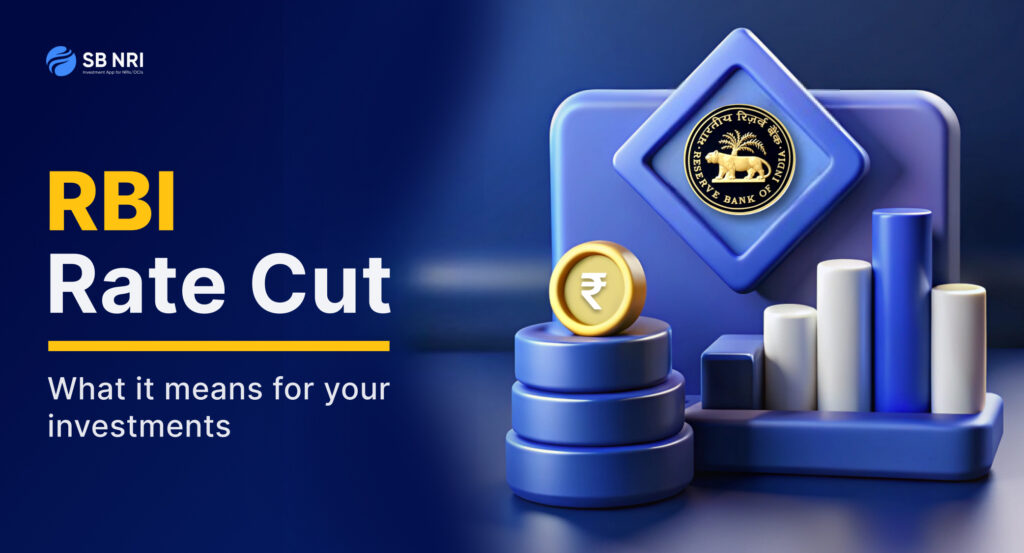
The Reserve Bank of India (RBI) often makes headlines for changing something called the repo rate. You might hear that it was “cut by 50 bps” or “increased to fight inflation.” But what do these changes actually mean? And why should you care about the RBI rate cut?
If you’ve ever wondered how RBI decisions impact your loans, FD returns, and investments, this guide is for you.
What Is the RBI?
The Reserve Bank of India is the central bank of the country. It controls the flow of money in the economy, ensures financial stability, and keeps inflation in check.
Some of the RBI’s main responsibilities are:
- Deciding interest rates
- Controlling inflation
- Regulating banks
- Managing money supply
- Supporting economic growth
What Is the Repo Rate?
The repo rate is the interest rate at which the RBI lends money to commercial banks when they’re short on funds.
Think of it this way:
If banks borrow at a lower rate, they can lend to customers (like you and businesses) at lower rates. That’s why when the RBI cuts the repo rate, loan interest rates usually come down.
Why Does the RBI Cut or Raise Rates?
The RBI adjusts interest rates depending on the situation of the economy. Here’s how it works:
| Situation | RBI Action | Why? |
|---|---|---|
| High inflation | Raises repo rate | To reduce spending and control prices |
| Slow economy | Cuts repo rate | To make loans cheaper and boost spending |
| Liquidity crisis | Infuses money + cuts rates | To support banks and businesses |
So, RBI rate cuts are often used to support growth, especially during tough times like economic slowdowns, low demand, or global uncertainty.
What Happens When the RBI Cuts the Repo Rate?
Here’s how a rate cut affects different parts of your life and the economy:
1. Loans Become Cheaper
Banks borrow at lower cost, and pass that on to customers. That means:
- Lower home loan rates
- Reduced car loan EMIs
- Better offers on personal loans
Even a small rate cut can reduce your monthly EMI by thousands of rupees over time.
2. FD Returns Fall
Fixed deposits become less attractive after a rate cut. Banks lower FD interest rates to match the new borrowing environment.
For example:
- If your bank was offering 7.25% on a 1-year FD, it might now offer 6.85% or lower after a cut.
- Over time, this reduces your real return, especially if inflation is still present.
3. Stock Markets May Rise
Lower interest rates mean:
- Companies can borrow more and expand
- Consumers can spend more
- Business profits improve
All of this tends to push up the stock market, making equity investments more attractive.
How RBI Rate Cuts Affect Different Sectors
Here are some of the key sectors that benefit from a falling interest rate environment:
- Real Estate: Lower home loan rates boost housing demand
- Automobiles: Cheaper vehicle loans can drive car sales
- Banking & NBFCs: Higher loan demand can improve profitability
- Consumer Goods: More spending power = more sales
- Capital Goods & Infra: Easier borrowing helps fund expansion projects
The 2025 Repo Rate Cut
To support economic growth and respond to low inflation, the RBI in 2025 has already:
- Cut repo rates from 6.5% to 5.5% (100 bps total)
- Injected liquidity into the banking system
This is the third rate cut this year, and the biggest single cut (50 bps) since May 2020.
What it means for you:
- Your EMIs may go down
- Your FD rates are likely to drop further (they’ve already fallen ~0.40% since the last two cuts)
- Equity markets may benefit, especially sectors tied to credit and consumption
Should You Rethink Your FD and Investment Strategy?
With FD rates dropping and inflation still present (even if lower), traditional savings options may not deliver enough growth.
If you’re saving for long-term goals, consider:
- SIP in mutual funds
- Diversified equity investments
- Debt funds (if you want lower risk than stocks)
Investing a portion of your EMI savings from lower loan rates into a monthly SIP could help you build wealth over time — without needing a big commitment.
Final Thoughts
RBI’s rate cuts are not just for banks and businesses — they affect your personal finances too.
Lower interest rates can be a good opportunity to:
- Refinance your loans
- Start investing
- Shift from low-return options like FDs to growth-focused ones
Understanding how the RBI works — and how repo rate cuts affect your money — can help you make smarter financial decisions in any market environment.
Frequently Asked Questions (FAQs)
1. What is the repo rate?
It’s the interest rate at which RBI lends to commercial banks.
2. Why does RBI cut the repo rate?
To reduce borrowing costs, increase spending, and support economic growth.
3. How do rate cuts affect EMIs?
Lower repo rates often lead to cheaper loans, which means lower EMIs for borrowers.
4. Do FD returns fall when repo rate falls?
Yes. Banks reduce FD interest rates in response to repo rate cuts.
5. Which sectors benefit from RBI rate cuts?
Real estate, auto, banking, consumer goods, and capital goods often see a positive impact.
6. Should I invest in FDs now?
FDs may offer lower returns after rate cuts, making them less effective against inflation.
7. What should I do with the money I save from lower EMIs?
Consider starting a SIP or investing in mutual funds to grow that money over time.



